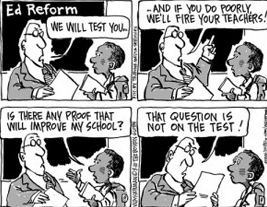Synthesis
The United States educational system has continued to feel the adverse impacts of George W. Bush’s 2001 policy known as “No Child Left Behind” (NCLB). This policy mandated that every student attending public school in grades 3-8 and 10-12 be required to take annual standardized testing, the results of which were then used to assess the progress of the school.21 The primary goals of NCLB were to bring all students to a proficient level on the standardized tests, hold states and schools accountable for scores, and to ensure that schools with Title I funds met yearly progress goals for all students, regardless of ethnicity, disabilities, economic disadvantages, or English-language learners.21 Two different scholarly articles delve into the adverse effects of high-stakes testing: “Rational Responses to High-Stakes Testing: The Case of Curriculum Narrowing and the Harm that Follows” written by David Berliner in 2011, and “Negative Impacts of High-Stakes Testing” written in 2012 by Michaela Minarechova.
Berliner’s article discusses the negative effects of high-stakes testing, with particular emphasis on response to test pressures. When standardized testing became mandatory for all public schools and school funding was tied to those results, added pressure was put on teachers and administrators. This additional pressure caused some to cheat and others to frequently break the procedures that went with the tests.20 Also, as the amount of pressure surrounding the tests increased, teachers spent more time strategizing with their students and preparing them for the tests, therefore causing a decline in the amount of learning exposed to students.20 The worst outcome of this pressure caused teachers and administrators to move students that would not likely pass the test out of schools, by telling them to stay home, sending them on trips, or treating them poorly with the intention of making them drop out of school.20 Another response to pressure to pass the tests includes narrowing curriculums. This concept refers to core academic subjects, like English, math and science, being given time and resource precedence over other subjects, such as social studies, music, art and physical education. 20 Narrowing curriculums also caused teachers to exclude information from lesson plans if the information will not be asked on the tests. 20
The article by Minarechova discusses the impact of high-stakes testing, particularly on students, teachers and administrators. Students become frustrated as a result of having to take these tests, which causes a resultant decline in effort.21 Also, the added emphasis that teachers and administrators place on students to pass the tests has resulted in students becoming more competitive with one another. 21 Students have been found to undervalue their grades and other school assessments. 21 Teachers are impacted by these tests in that they are encouraged to spend more time teaching subjects and instructions that will increase test scores, rather than on lesson plans. 21 As a result, teachers feel that their sense of professional worth is devalued. 21 Lastly, administrators are pressured to enact policies to heighten test scores, rather than emphasizing learning in the school environment. 21 Administrators also tend to reallocate resources to the subjects being tested, thus causing a higher probability of wasted resources. 21
Both of these articles address the negative aspect of mandatory high-stakes testing as a direct result of NCLB. These impacts are particularly prevalent today as evidenced by the multitude of organizations that are trying to get the tests eliminated from the public schools. These opposition efforts should continue because high-stakes testing is making more problems than solving them.
 26
26
 27
27
Links
Rational responses to high stakes testing: the case of curriculum narrowing and the harm that follows by David Berliner20
Negative impacts of high-stakes testing by Michaela Minarechova21
Warning: Links may not work if you are not a subscriber to the academic journal
